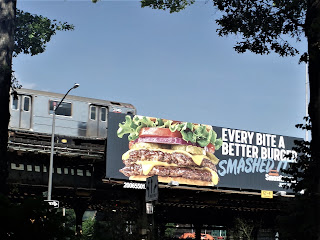Walking along the picturesque pathway from Battery Park City to Battery Park proper—which up until the mid-1960s would have placed me in the Hudson River—I encountered ominous banners on partially painted blue lampposts. The blue paint climbed the posts to the estimated storm-surge level during a “100-year storm” in 2050. Thus, on a beautiful and dry August morning in 2022, I had something to mull over—our dire future with its myriad misfortunes—and a little arithmetic to do, too. Yes, I could still be breathing in 2050, but I’d be pretty ancient with my strolling around Battery Park days in the distant rearview mirror.
Further down the same pathway put me in a pleasant piece of parkland named after a devoted public servant and the son of former three-term New York City mayor Robert F. Wagner, Jr. As I recall, Robert F. Wagner, Jr.—the son with the same name—maintained a mournful but earnest countenance. He was—by all indications—a truly dedicated and scrupulously honest man, atypical among the pandering and posturing Gotham pols of his day. Signs posted on this neatly manicured, green sliver of earth imparted a different tale of woe. Robert F. Wagner, Jr. Park, with its popular, independently owned restaurant with views of Lady Liberty and—most appreciated—a well maintained public restroom would soon be closed for extensive renovations. To address the previous signs’ portentous possibilities, the work is expected to take two years.
I Googled Robert F. Wagner Jr. Park and learned more about the plans for the new and improved Robert F. Wagner Jr. Park. It would be raised ten feet, considerably altered with less green space, and emerge resilient. Well, that’s the plan anyway. I appreciate that—when the sea is angry—that sliver of Manhattan is especially vulnerable to flooding. You don’t have to be a marine biologist to come to that conclusion.
Still, anytime a government project is proposed, it should be looked upon with a critical eye. And the neighbors should be fully apprised about the goings-on. Just around the bend of Manhattan Island from Robert F. Wagner, Jr. Park, engineers are preparing for the future’s anticipated sea-level rises. Nevertheless, the question remains: Is this makeover a necessity at this moment in time or a boondoggle—its price tag is $221 million—feathering certain people’s nests at the expense of others? For starters, I would wager that it will take more than two years to complete this transformation scheduled to commence next month. And what about the restaurant and—lest we forget—the restrooms? There’s a contented squirrel population there, as well, along with dozens of mature trees, including maples and weeping willows. The park’s only a quarter of a century old. Too young to die? Or has its time—courtesy of climate change—come? Should Robert F. Wagner, Jr. Park get with the program? Is it a matter of adapt or die a watery death down the road? I can't say for sure, but were I a squirrel, I know what my answers to the above questions would be.
(Photos from the personal collection of Nicholas Nigro)














